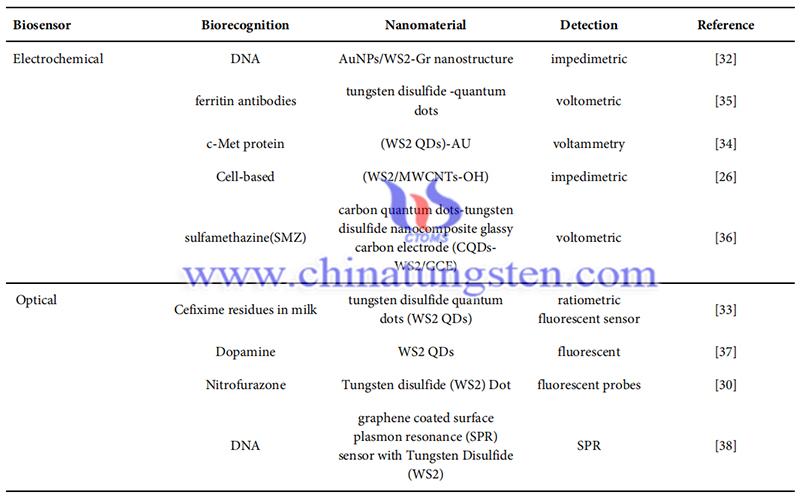Tungsten Disulfide Nanomaterials (WS2NM) for Biosensors - Ⅰ
- Details
- Category: Tungsten Information
- Published on Thursday, 11 August 2022 11:12
Tungsten disulfide nanomaterials (WS2NM) are new nanostructures that could be a new option for biosensors. Bio-sensors were developed as a combination of bioreceptors and sensors and are classified according to their elements. They are usually classified into three categories based on the transducer, including electrochemical, optical, and electrical conductivity methods. Meanwhile, the classification of biomarkers is based on molecules, cells, and tissues.

(Picture source: Niknam S./Nanomed Res J)
Typically, the fabrication of a biosensor requires the following three steps. The first step involves the reaction of the biomarker with the desired analyte, while the second step is the integration of the sensor and the last step is the fixation/mobilization of the biological component to the sensor. It is worth noting that the quality of these three stages and the currency of the components are very effective in achieving successful results. The great interest in bio-sensors is due to their speed and accuracy in detecting small analytes. According to this fact, the rate of bio-sensors in combination with different nanomaterials and biomaterials for biomedical research has expanded.
Recently, the products of nanobiosensors have proposed new ways to detect biomolecular interactions. A great deal of research has been carried out on the design and fabrication of loading techniques and support carriers for electrochemical bio-sensors. Nanomaterials are rapidly developing as an important research area because of their specific chemical and physical properties for the production of bio-sensors with better analytical performance.
Sensors are one of the important components of biosensors and are responsible for demonstrating the interaction of biomarkers with target analytes in a recognizable and reproducible manner, which requires the conversion of specific biochemical reaction energies into visual structures. The high surface-to-volume ratio of nanomaterials is justified because the sensor is responsible for facilitating a more accurate identification of biochemical reactions.
Furthermore, the electromechanical properties of nanoparticles can be an excellent adjunct to biosensor technology. the combination of the highly anisotropic nature of WS2, which affects the electrical and mechanical properties, provides extremely interesting results in catalytic reactions.

(Picture source: Niknam S./Nanomed Res J)
Nowadays, researchers focus on improving the sensitivity and specificity of bio-sensors by surface modification, focusing on the evolution and fabrication quality of nanobiosensors, which involves the application of different nanomaterials such as nanosheets, nanoparticles or quantum do to extend the affinity and improve the signal amplification. The following section summarizes recent advances in the use of WS2 as a sensing platform for biomolecule detection using its optical and electrochemical properties, with a special emphasis on its application in the overall sensing field.
Cited article: Niknam S., Ahmad Dehdast S., Pourdakan O., Shabani M., Kazem Koohi M. Tungsten Disulfide Nanomaterials (WS2NM) Application in Biosensors and Nanomedicine, A review. Nanomed Res J, 2022; 7(3): 214-226. DOI: 10.22034/nmrj.2022.03.001
- Tungsten Manufacturer & Supplier, Chinatungsten Online: www.chinatungsten.com
- Tungsten News & Prices of China Tungsten Industry Association: www.ctia.com.cn
- Molybdenum News & Price: news.molybdenum.com.cn
- Tel.: 86 592 5129696; Fax: 86 592 5129797; Email: sales@chinatungsten.com



 sales@chinatungsten.com
sales@chinatungsten.com